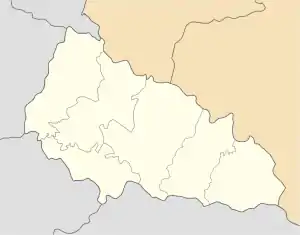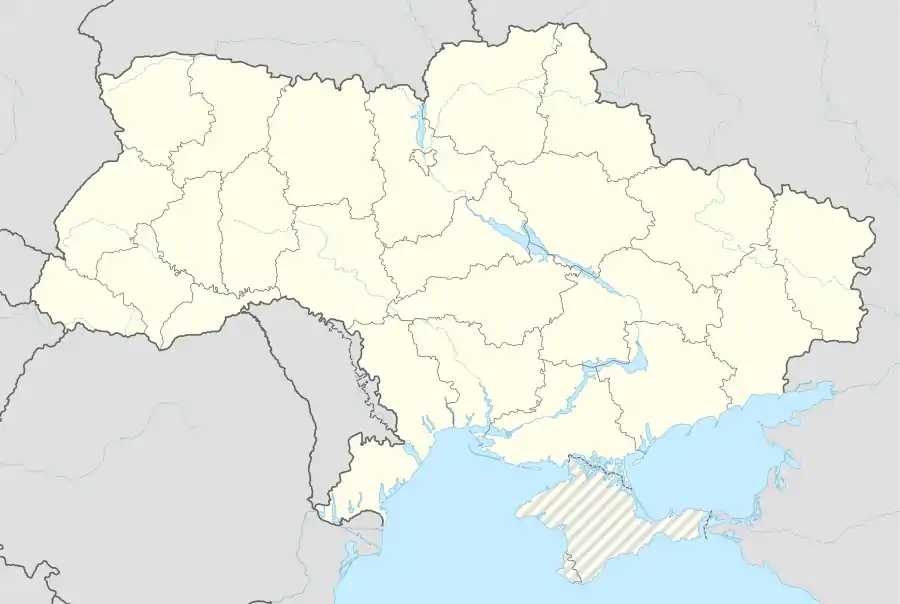Iza, Ukraine
Iza (Ukrainian: Іза}, Hebrew: איזה, German: Isa, Russian: Иза) is a village in the Khust Raion of Zakarpattia Oblast in western Ukraine. It is located between two mountain ranges, on the left bank of the river, 5 km from the Khust city center and railway station. The population is 5,800 (2018).
Iza
Іза | |
|---|---|
Village | |
.jpg.webp) | |
 Iza Location of Iza  Iza Iza (Ukraine) | |
| Coordinates: 48°12′50″N 23°19′43″E | |
| Country | |
| Oblast | Zakarpattia Oblast |
| Founded | 1646 |
| Elevation | 319 m (1,047 ft) |
| Population (2018) | |
| • Total | 5,800[1] |
| Time zone | UTC+1 (CET) |
| • Summer (DST) | UTC+2 (CEST) |
| Postal code | 90441 |
| Area code(s) | +380-3142 |
History
On the occupation of the territory of Iza in the 1st millennium BC. indicate two burial mounds in its outskirts. The first group of mounds is to the right of the road beyond Lipchy, the second is northeast, closer to the village. The burial grounds were investigated by the Zatlukal brothers in 1939-1940, M. Yu. Smishko in 1948-1949 and VG Kotigoroshko in 1975-1976. The burial culture of Carpathian mounds of the 1st - 4th centuries AD has been investigated.
The first written references to Iza date back to 1387. The legend relates the name of the village to the name of the first settler of Isaiah, which was later quite common here.
In the 1600s the inhabitants of Iza were the serfs of the Khust dominion, and then the feudal lords of the Sigmunds . The population was mainly engaged in agriculture - they sowed mainly rye , barley , wheat , oats . Livestock also developed . In addition, fishing and hunting were common here. In the rivers Tisza and Rica were many fish and in the surrounding forests - game. The serfs paid monetary and natural repayments, and also practiced serfdom. They gave domination one-tenth of the crop, one-tenth of the cattle , a certain number of chickens, eggs , geese , a set sum of money , kept dominant cattle during the winter. The inhabitants of Iza took part in the peasant war of 1514 under the direction of Djerd Doge and other popular speeches. In 1646 a union was introduced here.
Ukrainian writer-polemicist Michael Andrell lived in Iza. Here he died and is buried. In 1768 there were 79 peasant farms in Iza, which had only half of the land in use. The size of the serfdom was not limited in any way: the peasants worked at home one week, the next - in the serfdom in favor of the landowner. Particularly difficult was the work on the landlords during the harvest. In 1786, more than a third of Iza's people died during the famine.
In 1830 1198 people lived in the village. As a result of the revolution of 1848-1849, serfdom was abolished.
At the end of the XIX century in the village of widely spread fishing weaving baskets from vines . One of his ancestors was Ivan Kashko. He taught this craft to two sons, and then a few more residents of the village began to engage in it. They sold their wares at the market in Khust and other cities. In the years 1909 - 1910 many of the landless and landless residents of Iz were busy with basket weaving. This fishery gradually improved. In addition to the manufacture of baskets, glass wine bottles , as well as chemicals manufactured by the Clotilda Joint Stock Company in Big Bychkov, were woven here with the vine. In the summer, the peasants prepared the vine, cleaned it from the bark, dyed it, and engaged in weaving in the winter.
In the early twentieth century, Iza was a large village of Maramora County. Whereas in 1873 there were 365 dwellings and 1,707 inhabitants, in 1900 there were 519 dwellings and 2,505 inhabitants. Of the total population of 2 248 people (90 percent) were Ukrainians, 219 were Germans, 36 were Hungarians, 42 were Romanians. 7 706 cadastral holdings of land were attributed to the village.
Since 1899 an elementary school has been operating in Iza. It was taught in Hungarian . In the 1908/09 school year, two teachers taught 120 students at the school. In 1900 , only 433 residents were able to read and write. Ivan Rakovsky, who lived in the village from 1859 to 1885, opposed the policy of national oppression of the Ukrainian population. He came here from Budapest, where he was the editor of several Russian periodicals. He died in Iza, where he was buried.[2]
After the collapse of the Austrian Empire in 1918, the village was occupied by Hungary, Romania (late April 1919), and in September Czechoslovakia was established there.
In the 1920s - 1930s in the village began to engage in carpentry, and weaving. Isian carpenters were known far beyond the village. A small part of the inhabitants worked with carriages. The rural poor were paid to the rich by a meager payment.
Ukrainian elementary schools have been operating in Iza since 1919, and Czech ones since the beginning of the 1930s. In 1938, 300 pupils were enrolled in both primary schools and 14 teachers were employed. There was a library and a reading room. In 1939 , there were 3 631 people living in the village and there were 761 dwellings. Jews probably settled in Iza in the first half of the 18th century.
World War Two
From March 15, 1939, the village was part of the Carpathian Ukraine , but already on March 18, Hungarian troops occupied Iza. A concentration camp was built near the village.[3]
With the Hungarian occupation of Iza in March, 1939, Jews were persecuted and pushed out of their occupations. In 1940-41, dozens of Jews from Iza were drafted into forced labor battalions and others were drafted for service on the Eastern front, where most died.
In 1941, a few Jewish families without Hungarian citizenship were expelled to Nazi occupied Ukrainian territory, to Kamenets-Podolski, and murdered there.
The remaining Jews of Iza were deported to Auschwitz late May, 1944.[4]
Economy
Iza is known for the handmade baskets sold in the village.[5] There is also a farm where spotted deer are raised.[6]
References
- https://khust-rda.gov.ua/selo-iza-14-05-26-27-09-2018/
- Danylo Husar Struk: Encyclopedia of Ukraine: Volume IV: Ph-Sr, 1993
- http://shtetlroutes.eu/en/khust-putvnik/
- https://kehilalinks.jewishgen.org/Iza/
- https://web.archive.org/web/20160305202416/http://woodex.ua/?service_id=3&nid=2362&rid=2&y=2006&m=6.
- https://prokarpaty-tour.info/uk/selo-iza-lozopletenie-v-zakarpatie/
- Struk, Danylo Husar (1993). Encyclopedia of Ukraine: Volume IV: Ph-Sr. Canada: University of Toronto Press.